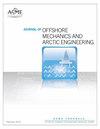半潜式浮式风力发电机的使用极限状态评估
IF 1.3
4区 工程技术
Q3 ENGINEERING, MECHANICAL
Journal of Offshore Mechanics and Arctic Engineering-Transactions of the Asme
Pub Date : 2023-10-03
DOI:10.1115/1.4063618
引用次数: 0
摘要
摘要浮式风力发电机组的设计应满足其在整个寿命周期内的安全高效运行的使用极限状态要求。SLS要求是由风力涡轮机设施的所有者/开发商引入的,目的是实现发电或设施的有效运行,或者是确保安全的第一步。目前,设计标准中关于SLS需求的信息有限。本研究涉及对SLS设计检查的现行方法、标准和程序的评估,重点是考虑到功率生产及其波动的倾斜/俯仰和短舱加速度。此外,还简要讨论了在适用性和安全性标准之间的其他标准,例如与间隙有关的标准。在北海北部海上的一个10兆瓦半潜式FWT的案例研究中,说明了与电力生产相关的标准。从可使用性的角度进行了静态和动态分析,并在实例研究中进行了讨论和应用。了解风力发电机的动态性能与可维护性是促进设计决策的必要条件。研究了风浪荷载对不同SLS准则的相对贡献。最后,总结了本文的主要结论。我们希望本研究能够为提高fwt半潜式浮子设计的设计标准、指导研究和工程实践提供依据,以替代目前fwt对SLS要求的现状。本文章由计算机程序翻译,如有差异,请以英文原文为准。
SERVICEABILITY LIMIT STATE ASSESSMENT OF SEMI-SUBMERSIBLE FLOATING WIND TURBINES
Abstract The design of a floating wind turbine (FWT) should satisfy the serviceability limit state (SLS) requirement for an efficient and safe operation throughout the entire work life. The SLS requirements are introduced by the owner/developer of the wind turbine facility to achieve production of power or an efficient operation of the facility or a first step towards ensuring safety. Currently, there are limited information about SLS requirements in design standards. This study deals with an assessment of current methods, criteria and procedure for the SLS design check with an emphasis on tilt/pitch and nacelle accelerations in view of power production and its fluctuations. Moreover, other criteria, on the borderline between serviceability and safety criteria, e.g. relating to clearance, are briefly discussed. The criteria relating to power production are illustrated in a case study with a 10-MW semi-submersible FWT considered for an offshore site in the Northern North Sea. Static and dynamic analysis in terms of serviceability are presented, discussed and applied in the case study. A good understanding of wind turbine dynamic performance associated with serviceability is essential to facilitate design decision-making. The relative contribution of wind and wave loads to the different SLS criteria is investigated. Finally, the main conclusions are summarized. I lieu of the current state of the art regarding SLS requirements for FWTs, we hope that this study provides a basis for improving design standards and guiding research and engineering practice for the semi-submersible floater design of FWTs.
求助全文
通过发布文献求助,成功后即可免费获取论文全文。
去求助
来源期刊
CiteScore
4.20
自引率
6.20%
发文量
63
审稿时长
6-12 weeks
期刊介绍:
The Journal of Offshore Mechanics and Arctic Engineering is an international resource for original peer-reviewed research that advances the state of knowledge on all aspects of analysis, design, and technology development in ocean, offshore, arctic, and related fields. Its main goals are to provide a forum for timely and in-depth exchanges of scientific and technical information among researchers and engineers. It emphasizes fundamental research and development studies as well as review articles that offer either retrospective perspectives on well-established topics or exposures to innovative or novel developments. Case histories are not encouraged. The journal also documents significant developments in related fields and major accomplishments of renowned scientists by programming themed issues to record such events.
Scope: Offshore Mechanics, Drilling Technology, Fixed and Floating Production Systems; Ocean Engineering, Hydrodynamics, and Ship Motions; Ocean Climate Statistics, Storms, Extremes, and Hurricanes; Structural Mechanics; Safety, Reliability, Risk Assessment, and Uncertainty Quantification; Riser Mechanics, Cable and Mooring Dynamics, Pipeline and Subsea Technology; Materials Engineering, Fatigue, Fracture, Welding Technology, Non-destructive Testing, Inspection Technologies, Corrosion Protection and Control; Fluid-structure Interaction, Computational Fluid Dynamics, Flow and Vortex-Induced Vibrations; Marine and Offshore Geotechnics, Soil Mechanics, Soil-pipeline Interaction; Ocean Renewable Energy; Ocean Space Utilization and Aquaculture Engineering; Petroleum Technology; Polar and Arctic Science and Technology, Ice Mechanics, Arctic Drilling and Exploration, Arctic Structures, Ice-structure and Ship Interaction, Permafrost Engineering, Arctic and Thermal Design.

 求助内容:
求助内容: 应助结果提醒方式:
应助结果提醒方式:


